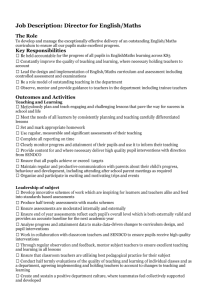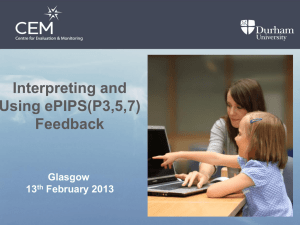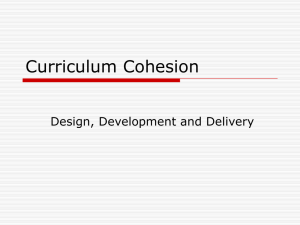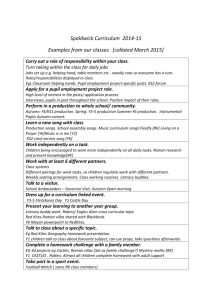Scottish Heinemann Maths and the Programme of Study
advertisement
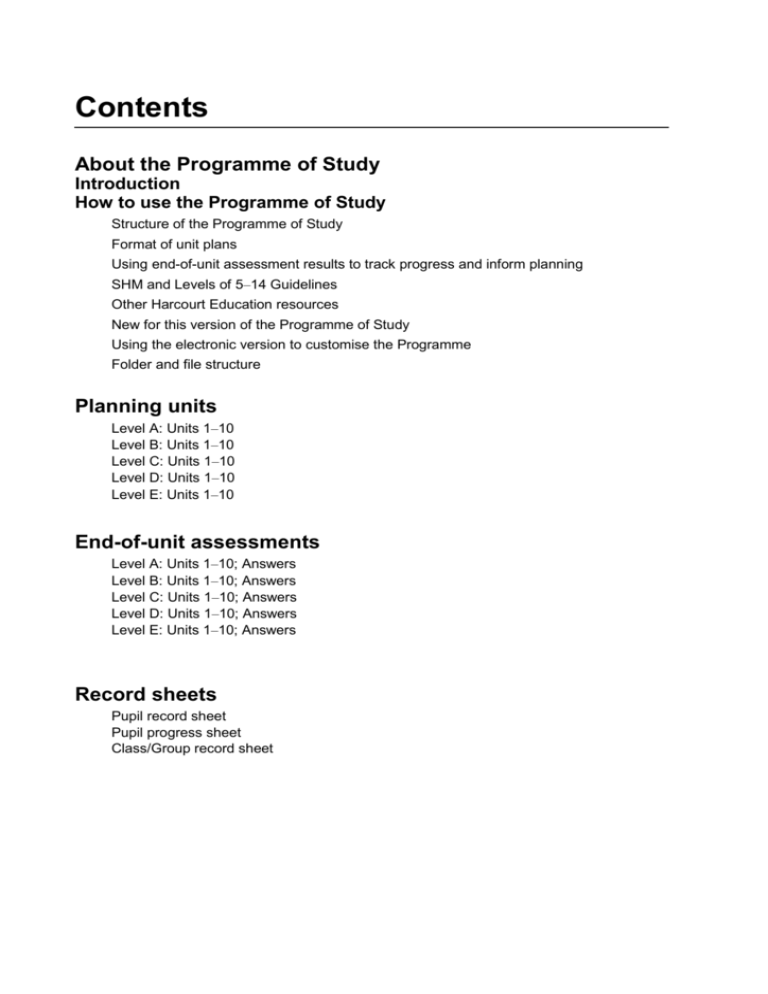
Contents About the Programme of Study Introduction How to use the Programme of Study Structure of the Programme of Study Format of unit plans Using end-of-unit assessment results to track progress and inform planning SHM and Levels of 5–14 Guidelines Other Harcourt Education resources New for this version of the Programme of Study Using the electronic version to customise the Programme Folder and file structure Planning units Level A: Units 1–10 Level B: Units 1–10 Level C: Units 1–10 Level D: Units 1–10 Level E: Units 1–10 End-of-unit assessments Level A: Units 1–10; Answers Level B: Units 1–10; Answers Level C: Units 1–10; Answers Level D: Units 1–10; Answers Level E: Units 1–10; Answers Record sheets Pupil record sheet Pupil progress sheet Class/Group record sheet Introduction This Scottish Programme of Study for Maths has been written to help teachers using Scottish Heinemann Maths and other Harcourt Education resources to deliver the requirements of the 5–14 Guidelines for Mathematics. The Programme of Study covers Levels A-E. For ease of forward planning and teaching, each Level of the 5–14 Guidelines has been divided into 10 units. This means that a child who is on, for example, Unit 6 of Level C, may be considered as being about 60% through Level C. If it takes an average of 7 weeks to teach each unit, pupils should complete Level D by around the end of P7. However, the pace of teaching will of course vary from group to group and class to class. Each unit has been designed to cover a broad range of maths topics, revisiting and building on previous teaching and progressing children’s learning in small, continuous steps. The Programme of Study provides a test for each unit, covering the key concepts taught in the unit. Teachers can use the results of these tests to monitor the progress of their pupils and to inform their forward planning. They can also be used as a basis for formative assessment, helping to establish where a child is in terms of the 5–14 Guidelines. The units in each level are roughly comparable in size, which facilitates the use of the Programme of Study as a long term planning tool, as well as serving as a record of work done. As currently written, the Programme of Study is one way of breaking down the 5–14 Guidelines into a series of smaller learning outcomes. However, it is not suggested that this is the only way of doing this, and teachers are encouraged to customise the plans in order to meet the individual needs of their classes. The Programme of Study is a very flexible planning and assessment tool. You can print the plans as provided, and highlight, annotate and mark comments on your printout. Alternatively, you may wish to make changes electronically, in which case you can simply copy the files provided here on the website, make required changes, save and print your customised version. Because the Programme of Study is made available electronically it can be continually customised by teachers and schools to meet their needs. It can also be updated by Harcourt as additional resources are published appropriate to the Scottish curriculum. We suggest you return to the Harcourt Education website from time to time to check for updates: www.myprimary.co.uk How to use the Programme of Study Structure of the Programme of Study The Programme of Study for Maths has been written to help Scottish primary school teachers to deliver the requirements of the 5–14 Guidelines for Mathematics. It can be used as both a forward planning tool and also as a record of work completed. In order to reduce the burden of time-consuming planning, the Programme of Study has taken the outcomes of the 5–14 Guidelines and broken the teaching down into smaller steps. Each Level has been divided into 10 units, with each unit representing an average of 7 teaching weeks. If each unit in the Programme of Study takes an average of 7 weeks to teach, then pupils should cover Level D by the end of P7. If it is appropriate for some groups, teachers may choose to teach at a faster pace; if, for example, the average teaching time for such groups is reduced to 5.5 weeks/unit, then these pupils should cover Level E by the end of P7. The pace of teaching will, of course, vary from group to group, class to class, and teacher to teacher, and will also be affected by other curricular priorities and activities within individual schools. These figures of 5.5 and 7 weeks/unit are examples of averages, to be used only as guidelines to assist teachers in approaching their forward planning; teachers will need to continually assess and revise their own teaching plans according to the progress of their pupils. Teachers can use the end-of-unit assessments as part of this assess-and-revise process (see below). Using end-of-unit assessment results to track progress and inform planning The assessment provided for every unit covers the main concepts taught in that unit. The benefit of this mixed-maths approach is clear: unlike end-of-topic tests, which cover a single area of maths, in mixed-maths assessments, children really have to know the maths being assessed in order to work out what to do. In addition to concepts taught in each unit, the tests include a handful of questions which cover key concepts taught in earlier units. This approach ensures that teachers can keep on top children’s knowledge of important skills and concepts. (Such questions are indicated by an asterisk in the answers, e.g. * .) Any formal test results are, of course, a snapshot of a child’s performance on a particular day and should be used in conjunction with ongoing observational assessment. The tests can be done purely as written tests, or teachers may choose to conduct them as aural tests, reading the questions aloud at an appropriate pace. (Note that, whereas the tests for Levels A–D are single-page tests, the Level E tests are 2 pages in length.) For consistency, each assessment contains 20 questions, which enables teachers to compare children’s performances in different tests, for example to see whether individuals are improving or perhaps falling behind their group, which will therefore have implications for the pace of teaching. Teachers can use an individual pupil’s assessment results across a period of time to build a picture of how well that pupil is progressing, and subsequently use this information in their future planning. For example, if a child consistently receives marks of 18–20 for a number of assessments, then the teacher can assume that the child is coping extremely well, and could probably cope with a faster pace of teaching. If a pupil consistently receives marks in the region 14–17, then the teaching is probably at about the right pace. If a pupil consistently scores 13 or less, then they are probably not grasping the concepts, and may benefit from a slower pace and more consolidation. Teachers can also use test results diagnostically. Widespread failure by the group or class on the same questions or concepts is a good indication that some re-teaching and further consolidation is needed on these topics before moving on to the next unit. Because the units in each Level are roughly comparable in size, teachers can use their progress through the units as a guide to children’s overall progress in a Level. For example, if a child performs well in the Level B end-of-unit 5 assessment, their teacher can confidently assess that child as being about halfway to achieving Level B. The Programme of Study’s structured progression and comprehensive coverage of concepts means that children will have had many opportunities to consolidate and practise their skills and knowledge. By the time a child has completed unit 10 in any of the Levels, teachers can expect them to have a high degree of confidence and competence at that Level. (It is likely that some children could ‘achieve’ a Level some time before completing unit 10, after unit 7 for example. However, their attainment would probably not be as solid as it would be when they completed unit 10.) Used in conjunction with other test results, the results in the 10 tests in a Level provide a wide base of evidence of Level attainment. Calculations in the assessments are presented both horizontally and vertically. A horizontal layout implies children should do the calculation using mental methods, whereas a vertical layout suggests they will use a written algorithm. Answers to all tests within a Level are provided in a separate file, located in the folder of tests for that Level. Using record sheets The Programme of Study provides 3 different record sheets for teachers to record their pupils’ results. Teachers do not need to use all 3 sheets – they are designed to provide teachers with a range of recording options. All of the sheets are editable and can be customised to suit individual teacher’s needs. 1 1 Gr Pupil record sheet is designed for The ou teachers to record individual pupil’s p assessment results, along with observational Gr comments to inform future planning. 2 ou p 2 Gr The Pupil progress sheet is designed so that ou an individual pupil’s progress throughout p primary school can be recorded and summarised. The sheet would be passed from one class teacher to the next. 3 3 The Class/Group record sheet is designed for teachers to record assessment results of a class or group. The summarised results on this sheet give at-a-glance information about progress and areas of weakness and strength, which is useful for future planning. Format of unit plans Each unit has the same format, and the features are illustrated below. 1 2 3 4 5 6 7 Space for teachers to customise the units for their own school Space to indicate commencement date Activities to develop children’s mental maths skills, ‘warming children up’ before the main part of the lesson, and consolidating facts learned in previous teaching Outcome/strand/target information from the 5–14 Guidelines (in bold) Learning outcomes linked to teaching in Scottish Heinemann Maths as the core resource Sections in SHM Teaching Files Pupil activities to practise concepts just taught; aimed at all children in group 1 8 9 10 11 12 13 Optional activities for pupils who need extra practice to consolidate concepts Optional harder activities for pupils who need some extension work Blank column for teachers to write own notes, activities, resources, customising the unit to meet their needs Resources for additional support in the areas of Shared teaching and Problem solving Space for teachers to record observations and plans for subsequent teaching End-of-unit test 2 1 pupil activities to practise concepts just1 pupil activities to practis taught; aimed at medium-ability children intaught; aimed at medium-a group group 3 7 8 9 10 1 optional activities for pupils who need 5 optional activities fo 1 pupil activities to practise concepts just 1 pupil activities 1 pupiltoactivities 1practise pupil activities to concepts practise tojust concepts practise extra practicechildren to consolidate concepts extra practice to consolida taught; aimed at medium-ability in taught; aimed taught; at medium-ability aimed taught; at aimed medium-ability children at medium-ab inchild 2 optional harder activities for pupils6who optional harder act group 4 group group group some extension work need some extension work 33 for concepts pupils who need 1 pupil optional activitiesactivities toneed practise just 17 optional 21 activities optional 25 for activities optional pupils who activities for pupils needfor w 6 3 blank column for teachers to write 7own blank column for te extra practice concepts taught; aimed to at consolidate medium-ability childrenextra in practice extra topractice consolidate extra to practice consolidate concepts to consolidate concept 1activities pupil activities to practise concepts just notes, activities, the notes, unit activities, resources 34 optional harder for resources, pupils who customising group 5 18 optional 22 harder optional 26 activities harder optional for activities harder pupils who activ for p taught; aimed at medium-ability children in to meet needs to meet their needs need some extension work 9 pupil optional fortheir pupils who need 1 activitiesactivities to practise concepts just need someneed extension some need work extension some extension work work group 4 for space for 8 space for teachers 35 blank column teachers to teachers write ownto record extra practice concepts taught; aimed to at consolidate medium-ability children19 in blank 23 column blank 27 for column teachers blank for column to teachers write for own tea to 13 optional activities for pupils who need observations and plans forunit subsequent teaching observations and plans for notes, activities, resources, customising the 10 optional harder activities for pupils who group notes, activities, notes, resources, activities, notes, activities, resources, customising resources, customis the uni extra practice test to consolidate concepts end-of-unit test to meet theirextension needsend-of-unit need work 29 some optional activities for pupils who to need meet their to meet needs their to meet needs their needs 14 optional harder activities for pupils who 36 space for teachers to record 11 practice blank column for teachers to write own extra to consolidate concepts 20 work space 24 for teachers space 28 forto space teachers record for teachers to recordto some extension observations andresources, plansneed for subsequent teaching notes, activities, customising the unit observations 30 optional harder activities for pupils who observations and plans observations and for subsequent plans and for plans subseque teachin for s 15 blank column for teachers to write own end-of-unit test to meet their needs work need some extension end-of-unitend-of-unit test end-of-unit test notes, resources, customising the unit test 12 space for teachers to activities, record 31 blank column for teachers to write own meet their needs observations andresources, planstofor subsequent notes, activities, customisingteaching the unit 16 space for teachers to record end-of-unit test to meet their needs observations and plans for subsequent teaching 32 space for teachers to record end-of-unit test observations and plans for subsequent teaching end-of-unit test 11 12 13 SHM and Levels of 5–14 Guidelines The Programme of Study has been structured so that one stage of SHM is completed before moving on to the next. Broadly speaking, SHM correlates to the Levels of the 5–14 Guidelines in the following way: SHM stage SHM1 SHM2 SHM3 SHM4 SHM5 SHM6 SHM7 Coverage most of Level A completes Level A, begins Level B completes Level B most of Level C completes Level C, begins Level D completes Level D, begins Level E completes Level E The following abbreviations have been used in the planning units to indicate which outcomes and strands from the 5–14 Guidelines the learning outcomes relate to: IH: Information handling (Because of the interrelated nature of the strands in Information handling, these have not been distinguished.) NMM: Number, Money and Measurement RTN: Range and type of numbers; Money: Money; AS: Add and subtract: MD: Multiply and divide; RN: Round numbers; FPR: Fractions, percentages and ratio; PS: Patterns and sequences; FE: Functions and equations; ME: Measure and estimate; Time: Time SPM: Shape, Position and Movement RS: Range of shapes; PM: Position and movement; Symmetry: Symmetry; Angle: Angle Scottish Heinemann Maths and the Programme of Study Although the Programme of Study has been written using Scottish Heinemann Maths as the core resource, the Programme itself is structured according to the attainment targets in the 5-14 Guidelines. Since Scottish Heinemann Maths contains some enrichment content that is outside the scope of the Guidelines, there is some SHM content which does not appear in the Programme of Study. Whilst not being essential for coverage of the 5-14 Guidelines, this content gives an expanded treatment of a number of topics and you may wish to add some of this to the Programme. Other Harcourt Education resources The Programme of Study has been written using Scottish Heinemann Maths as the core teaching resource, but in recognition that many schools use a range of different resources to deliver their maths teaching, a number of other Harcourt Education resources are also referenced. We’ve chosen resources that many Scottish schools already use – Abacus, Spotlight, Interactive Mental Maths and the Toolbox teaching software. A selection of activities from Abacus Mental Warm-ups and Interactive Mental Maths are referenced in the Mental agility section of the units. These are not an exhaustive list of activities relevant to the teaching in the unit, but do provide a good range of choice. Again, a selection of activities in Abacus, Spotlight and Toolbox has been made and these are mostly referenced in the Consolidation and Extension sections of the units. These are optional suggestions for pupil activities if teachers feel that some pupils either need further practice to consolidate the concepts being taught or need to be stretched by some harder activities. New for this version of the Programme of Study Since publication of the Programme of Study for Levels A-D in 2003 and Level E late in 2004, Heinemann and Ginn have published a number of resources that are relevant to Scottish schools, so we have taken the opportunity to update the original units to incorporate appropriate references into the teaching. To help you identify changes from the original Programme of Study, the new items are all indicated in red. SHM Software Software with pupil activities is available for all stages of Scottish Heinemann Maths. The use of this software can be integrated into normal class teaching and into extension activities. Number Reinforcement Sheets In response to teacher requests, Number Reinforcement Sheets are available for all years from P1 to P7. These give reinforcement and consolidation activities in all key aspects of number work required by the 5-14 Guidelines. Shared teaching Within Levels A and B, opportunities exist for shared teaching (whole class or groups) using Abacus Big Books. The activities in the Big Books can be used to introduce new topics to the whole class and to carry out a range of support and reinforcement activities for groups. References for these shared teaching activities are shown in the additional support section of each unit. Problem solving Activities to support the Problem Solving attainment outcomes are drawn from Problem-solving Toolkit and Groups Work. References for these problem solving activities are shown in the additional support section of each unit. All additional resources are referenced so you know when to incorporate them most effectively into your teaching if you already have them and you are using the Programme of Study. They are not mandatory, and you do not need to use all the references mentioned. You can also make use of resources that you already have in the school. Space is provided to create your own references to these extra materials. Contact your local Harcourt Maths, Science and ICT specialist if you want to know more about any of the series used in the Programme of Study. Also new: Additional Support A new section has been added to the end of each unit. This final section is called Additional Support, which gives suggestions for shared teaching activities for Levels A and B, and problemsolving activities for Levels A to E. Using the electronic version to customise the Programme The Programme of Study has been written to deliver the requirements of the 5–14 Guidelines for Mathematics, and can be used immediately without change or modification. However, teachers may wish to make changes to the Programme of Study in order to meet the needs of their individual classes and pupils. Such customisation may take a number of forms: altering the sequence of topics within and between units inserting tried and tested additional activities and resources, using the blank ‘Other’ column deleting/adapting existing references to resources adding extra columns/rows to the unit plans recording comments and forward planning information, using the blank ‘Next steps’ row To facilitate customisation, the unit plans have been designed using a Microsoft Word (97/98) template, compatible with both PC and Macintosh computers. We suggest you copy the original files to your hard drive, and make and save any changes there. If you do make changes to the maths concepts being taught, it will be important to check that these do not affect the integrity of the end-of-unit assessment. Re-ordering topics within a unit will not affect the accompanying test, but moving topics between units may well do so. The end-of-unit assessments are also provided as Microsoft Word documents, and are therefore editable. Please keep in mind, however, that answers are provided for the questions as originally written. If you change any questions, you will need to check and change answers accordingly. If you experience problems with the on-screen display or printing of the unit plans or assessments, please check that your computer has the system fonts Arial and Times loaded. Folder and file structure There are 4 main folders: General information about the Programme of Study Planning End-of-unit Record units for Levels A– E assessments for Levels A–E sheets All files are provided as editable Microsoft Word 98 documents, and are compatible with both PC and Macintosh systems. The first folder has an introduction to the Programme of Study as well as information about how to use it – how it is structured, how to use and edit the unit plans and assessments for forward planning, monitoring results and using this information to inform future planning. It also has general information about the 5– 14 Guidelines, SHM and other Harcourt resources. The second folder contains the planning units in 5 subfolders, with one subfolder per Level. The third folder contains the assessments and answers in 5 subfolders, again with one subfolder per Level. The fourth folder contains 3 record sheets, one for teachers to record results for individual pupils, and one for teachers to record overall class results. The third sheet can be used to record the results and progress of individual pupils throughout primary school.

